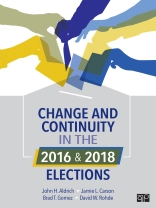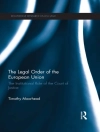Since its first edition in 1980, Change and Continuity has been known for offering the best analysis and explanation of voting behavior in the most recent election and setting those results in the context of larger trends and patterns in elections studies. This top-notch author team meticulously and accessibly explains the National Election Studies data and analyzes its importance and impact. Known for its current scholarship and excellent use and display of data, the text covers the most recent presidential and Congressional elections, voter turnout, and the social forces, party loyalties, and prominent issues that affect voting behavior. The 2016 and 2018 Edition will include new material on the congressional elections 2018 and an updated conclusion reflecting on what those results mean for the future of American politics.
Jadual kandungan
Tables and Figures
Preface
About the Authors
INTRODUCTION
Change and Continuity
Voters and the Act of Voting
Survey Research Sampling
Plan of the Book
PART I • THE 2016 PRESIDENTIAL ELECTION
CHAPTER 1 • The Nomination Struggle
Who Ran
The Rules of the Nomination System
Strategy and the Candidates’ Campaigns in 2016: The Electoral Setting and How the Candidates Won Their Nominations
CHAPTER 2 • The General Election Campaign
The Strategic Context and Candidates’ Choices
Political Context, Overall Strategy, and Opening Moves
From the Conventions to the Debates
The End Game and the Struggle over Turnout
Did the Campaign Make a Difference?
CHAPTER 3 • The Election Results
The Election Rules
The Pattern of Results
State-by-State Results
Electoral Change in the Postwar South
The Electoral Vote Balance
PART II • VOTING BEHAVIOR IN THE 2016 PRESIDENTIAL ELECTION
CHAPTER 4 • Who Voted?
Voter Turnout, 1789–1916
Voter Turnout, 1920–2016
Voter Turnout among Social Groups
Changes in Turnout after 1960
Election-Specific Factors
Does Low Voter Turnout Matter?
CHAPTER 5 • Social Forces and the Vote
How Social Groups Voted in 2016
How Social Groups Voted during the Postwar Years
Why the New Deal Coalition Broke Down
CHAPTER 6 • Candidates, Issues, and the Vote
Attitudes toward the Candidates
Prospective Evaluations
Issue Positions and Perceptions
Issue Voting Criteria
Apparent Issue Voting in 2016
Conclusion
CHAPTER 7 • Presidential Performance and Candidate Choice
What Is Retrospective Voting?
Evaluations of Government Performance on Important Problems
Economic Evaluations and the Vote for the Incumbent
Foreign Policy Evaluations and the Vote for the Incumbent
Evaluations of the Incumbent
The Impact of Retrospective Evaluations
Conclusion
CHAPTER 8 • Party Loyalties, Policy Preferences, and the Vote
Party Identification as Loyalty: The Original View
Party Identification as Retrospective Evaluation: An Alternative View
Party Identification, Polarization, and Identity: A Synthesis?
Party Identification in the Electorate
Hispanic Partisanship in 2008, 2012, and 2016
Party Identification and the Vote
Policy Preferences and Performance Evaluations
Conclusion
PART III • THE 2016 CONGRESSIONAL ELECTIONS
CHAPTER 9 • Candidates and Outcomes in 2016
Election Outcomes in 2016
Candidates’ Resources and Election Outcomes
The 2016 Elections: The Impact on Congress
The 2018 Elections and Beyond
CHAPTER 10 • The Congressional Electorate in 2016
Social Forces and the Congressional Vote
Issues and the Congressional Vote
Party Identification and the Congressional Vote
Incumbency and the Congressional Vote
The Congressional Vote as Referendum
Presidential Coattails and the Congressional Vote
Conclusion
CHAPTER 11 • The 2018 Congressional Elections
The Pattern of Outcomes
Assessing Victory and Explaining the Results
National and Local Influences in Congressional Elections
The 2018 Elections: The Impact on Congress
The 2020 Elections and Beyond
PART IV • THE 2016 AND 2018 ELECTIONS IN PERSPECTIVE
CHAPTER 12 • The 2016 and 2018 Elections and the Future of American Politics
Are Midterm Elections Predictive?
Prospects for the Democrats
Prospects for the Republicans
CHAPTER 13 • The Dynamics of American Elections
The Great Continuities: The Electoral System and the Party System
The Great Change: Depolarization and the Return of Partisan Polarization
Change and Continuity in Turnout
Continuities in Electoral Partisanship
Changes in the Partisan Electorate
Change and Continuity in the U.S. Congress
Appendix
Notes
Index
Mengenai Pengarang
David W. Rohde is Ernestine Friedl Professor of Political Science and director of the Political Institutions and Public Choice Program at Duke University. He is coeditor of Why Not Parties? (2008), author of Parties and Leaders in the Postreform House (1991), coeditor of Home Style and Washington Work (1989), and coauthor of Supreme Court Decision Making (1976).












